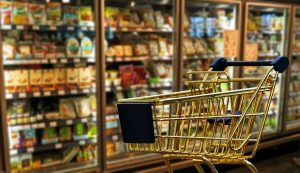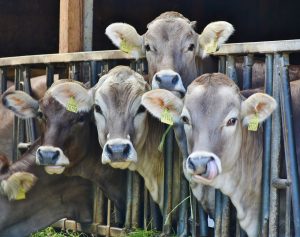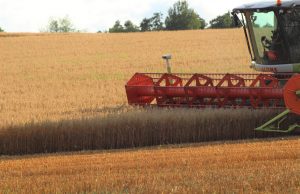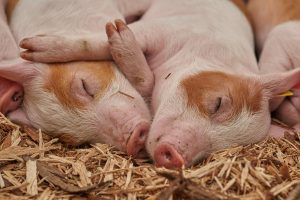Want to know one of the best-kept secrets to protecting the environment? Charlotte Willis explores how your diet may hold the key to our future…
Looking after the environment has, most likely, always been a concern for the majority of us. We’re taught from a young age to reduce the amount of paper we use, while diligently placing our washed cans and plastic bottles into the appropriate recycling bins and bags. We turn off the lights when we’re not using them, take showers rather than indulgent baths, and carry bags-for- life with us around the supermarkets. Yet, despite all of our best efforts, the environment remains in crisis. It begs the question, what more can we do?

Your continental latte
Now don’t get me wrong, I’m not about to suggest that if everyone ate the perfect environmentally- harmonious diet, living off the fat of the local, organic and sustainable land, we’d all be relieved of the impending climate-related doom encroaching upon us each and every day. There’s an undeniable leading role of mass industry and societal consumer patterns, a devious double act shaping the face of our future, and we have the government bodies around us directing their every move. But before we delve into a rabbit hole, let’s re-focus.
Without any shadow of a doubt, we can all make a difference. Each one of you reading this has the ability to make a marked improvement to the likelihood of a sustainable future for the planet during your everyday routine and choices. And in the most simple of ways, what you choose to eat and drink, might well be the answer.

If you think about it, each item of food, each snack and every drink you consume in a day has an extremely profound influence upon your carbon, water, emission and pollution footprints. Take that latte you sip. It’s made using Brazilian coffee beans roasted in the UK, milk from cows in the UK and is then packaged in a to-go cup which was made in China. So now, you’ve flown from Brazil to China and back again, just to grab a pick-me-up at 8.35 am. That’s pretty impressive, but also pretty scary.
And while I’m not suggesting you call it quits on your relationship with coffee (how dare I even postulate such a thing?), it’s definitely food for your morning commute thoughts.

Begin with your shop
Every time you eat or drink something, you could make the same inferences. Your USA-grown peanuts that go into your peanut butter on toast, Mexican avocados in your guacamole salad at lunchtime, the Thai-imported prawns in your evening stir-fry… can you see where I’m going with this?
World-leading researchers and scientists are continually highlighting the global impact of our diets upon the environment, linking the consumption of our modern diets to climate change. According to the WWF, our food intake is responsible for around 30% of global greenhouse gas emissions, with this proportion expected to skyrocket in the coming years if we fail to take action. Putting this statistic into context, the thousands of flights taken every single year only constitute 2% of the world’s greenhouse emissions.
What we eat is slowly, but surely, helping to send planet earth hurtling towards an early grave. Eating gluten-free, with the environment in mind, is pretty simple, and it doesn’t mean you’ll be munching on kale and GF oats for the rest of your days (unless you’re into that). Shopping smart, seasonally, and ensuring you watch out for a few harmful culprits by making more sustainable swaps, will all help you to transform your diet’s impact.
Here are some of the best ways you can help…
Buy local
Sourcing your fruit and vegetables as locally as possible is a brilliant place to start. If you’ve got time to find yourself a nearby marketplace or search online for local veg-box schemes, you’re already onto a winner. Buying from local farms will help you to eat seasonally, which will reduce the amount of imported fruits and veggies that you consume every day. If you’re not sure where to look, I would recommend you search online for a list or calendar of UK seasonally produced fruit and vegetables. You can then use this list to shop appropriately at your supermarket.
Seasonal fruit and vegetables are also highly nutritious and typically require less intensive agro-infrastructure to grow them. You’ll save water, save energy, emissions and perhaps a few pounds here and there. When it comes to bananas, tropical foods and imported goods, try to limit their use in your everyday cooking, using them for special occasions or cooking with them only around once per week.

Ditch dairy
Ah, dairy. The dairy industry produces an eye-watering amount of greenhouse gasses, uses an insane amount of water and contributes to the surface run-off pollution which negatively impacts on the environment around the farms. For example, One Green Planet reposts that an average dairy farm, with 700 cows in residence, uses 3.4 million gallons of water every single day in order to clean, feed and water their herds.
What’s more, it is estimated that the global dairy sector contributes 4% of total global human-generated greenhouse gas emissions. A fact which is made even more offensive when considering that just over half of this gas is methane, which has the ability to trap heat 100 times more efficiently than carbon dioxide.
With this in mind, ditching dairy from your diet in favour of gluten-free alternatives, such as soya, rice or hemp milk – all of which use less water, less land and contribute far fewer emissions than dairy milk per 200ml – is a brilliant way to help become more sustainable. Almond milk also uses less land and is more sustainable than dairy milk, but should be reduced in your diet due to the larger amount of water use involved in its production.

Choose your grains wisely
When choosing gluten-free alternatives to wheat and rye, making sure you opt for a sustainable grain is essential. Most grains have a pretty low water impact, with teff and millet being the most water-saving grains you can consume due to their hardiness and lower intensity to farm. Rice and far-flung imported grains such as quinoa should be consumed less often where possible, in favour of grains such as gluten-free oats and polenta, which are lower-impact alternatives. Overall, however, it is essential to choose to eat a variety of gluten-free whole grains every day in order to maximise your fibre and vitamin intake.
As with many fruits and vegetables, I would also recommend that you opt to purchase organic grains where possible, as these will be lesser sprayed with herbicides and pesticides, which pollute the atmosphere and the environment.

Consider your meat impact
As a final note, reducing your meat consumption is absolutely essential if you wish to have a positive impact upon the environment. We are told time and time again that meat is one of the biggest contributors towards environmental harm, and we can no longer ignore the threats from scientists. Choosing gluten-free alternatives such as tofu, tempeh, beans and legumes will not only help with your heart health, but also make a serious reduction in your carbon emissions.
